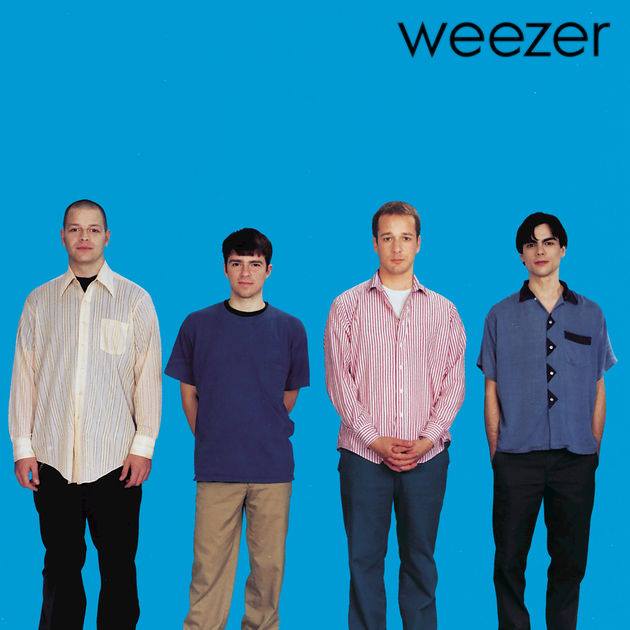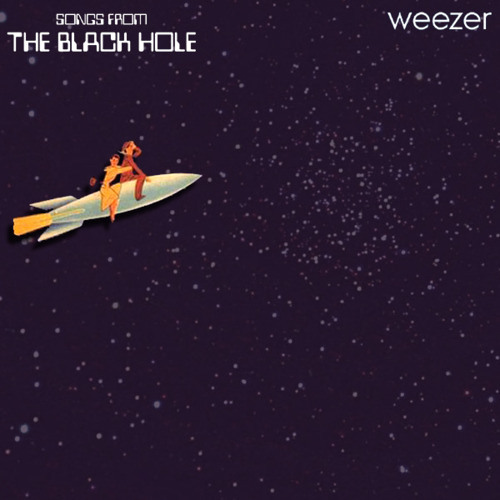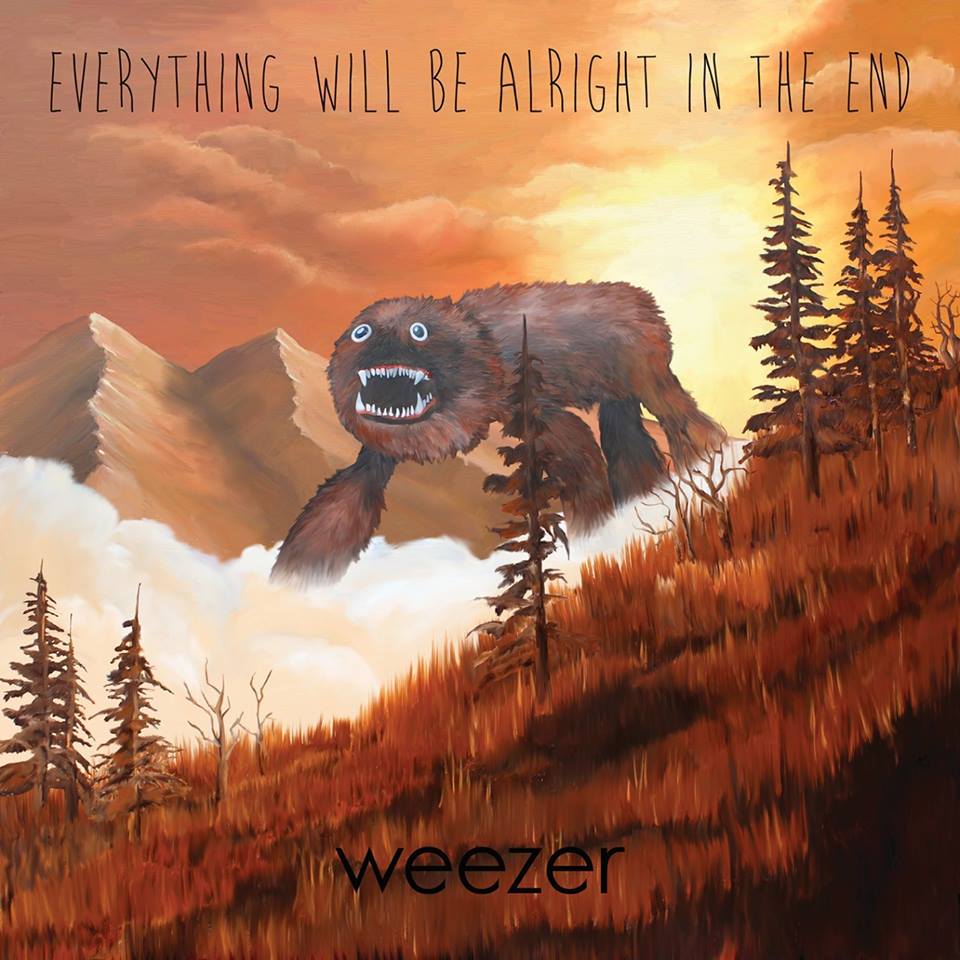On May 10, 1994, alt-rock band Weezer made waves across the music world with their self-titled debut, now universally known as The Blue Album. In a time when mainstream guitar-pop was dominated by the gloom and despair of grunge bands like Nirvana and Soundgarden, Weezer came on the scene with an unprecedented aesthetic of geeky and irony-ridden charm. However, their most recent album, The Black Album, was met with mixed-reviews and commercial failure. While some were disappointed by this year’s release, the good news is that lead singer-songwriter Rivers Cuomo has gone through a lot of changes over the years, attempting something new with each album and never sticking to one sound. This means that throughout their extensive catalogue of thirteen studio albums and countless compilations, there is a Weezer song for everyone, and I am determined to find yours. Here is a guide to find the Weezer for you!
Paper Face:

For those curious fans who wonder what Weezer could have been, “Paper Face,” featured on the band’s little known 1992 album, Opposite Sides of the Same Good Ol’ Fence, is the perfect starter. Cuomo initially started his musical life as the lead guitar player for hair-metal band, Avant Garde in the late ’80s, writing instrumental music and guitar solos. At the same time, he has always loved catchy tunes that stir your heart. “Paper Face” is especially representative of Weezer’s earlier music style, combining both of these elements through the heavy, fast-paced guitar and screaming vocals with a soft, melodic breakdown in between, ultimately revealing the origins of the Weezer we know and love today.
Click here to listen.
Undone (The Sweater Song):

For those who miss the “old Weezer,” look no further than, “Undone (The Sweater Song).” Written in 1991, this is the first Weezer song that Cuomo composed after moving from small-town Connecticut to sunny Los Angeles, filled with adolescent dreams of becoming a rock star. Influenced by the likes of Metallica, The Velvet Underground, and The Beach Boys, this song reflects the true essence of 90’s Weezer: a band who was trying to be clever and witty, simple and unpretentious, but whose metal roots unexpectedly seep through at every turn. With its’ spoken-word intro and avant-garde piano to close, the unusual combination of influences translate as ironic and charming, accentuating the band’s quirks and idiosyncrasies, which made them so popular in the first place.
Click here to listen.
Only in Dreams:

For those who love epic rock balladry, this song is a match made in (stairway to) heaven. Clocking in at eight minutes, “Only in Dreams” is Weezer’s most ambitious and lengthiest song to date, notable for its three-minute-long, 60-measure instrumental crescendo and romantic lyrics bordering on fantasy and surrealism. The driving rhythm of the bass line manages to hypnotize the listener while the song tells the story of its socially awkward narrator, a boyish Cuomo, pining over the girl of his dreams, an impossible fantasy: only in dreams. This lush, illusory track, which brings The Blue Album to its bittersweet end is an unquestionable tour de force and Weezer’s definitive rock ballad.
Click here to listen.
Blast Off:

For those interested in obscure, lost projects of beloved rock bands, “Blast Off” is the quintessential track for you. This is the first song from Weezer’s scrapped concept album, Songs from the Black Hole, a musical rock opera set in outer space which later developed into the beloved Pinkerton. The band’s unfinished masterpiece takes place in the year 2126 inside the main deck of the spaceship Betsy II. If this album were a play, “Blast Off” sets the stage; filled with a cast of characters, like crew members Wuan and Dondo, a robot named M1, and Captain Jonas who enters a love triangle with the ship’s cook Maria and his former lover Laurel. The off-kilter harmonies, jangly instrumentation, and experimental storytelling craft the perfect tune for those interested in Weezer’s mythos and for music historians who want to explore the rarities and dig beyond the band’s studio albums.
Click here to listen.
El Scorcho:

If you’re a fan of 2000’s emo and pop-punk music, look no further than the Pinkerton hit “El Scorcho.” This raw, self-produced single sprinkled with bizarre improvised vocals and a seemingly careless guitar riff has been cited as the leading inspiration for a number of popular bands like Blink-182, Fall Out Boy, and My Chemical Romance. Most notably though, the black swan called Pinkerton became every angst-ridden youth’s savior, a canon for an entire music culture called “emo.” On “El Scorcho,” Cuomo perfected his pseudo-rap used in later hits like Beverly Hills, and marks the first use of his “copy and paste” method of songwriting with the lyrics, “Watching Grunge leg drop New-Jack through a press table,” taken from an essay written by a classmate of Cuomo’s at Harvard University. The specificity of the verses complimented by the universality of the chorus makes for a great antithesis of the polished pop songs perfected on The Blue Album, inspiring a generation of artists in the new millennium. As Cuomo once stated, “I don’t really know what emo means. But apparently I had something to do with it.”
Click here to listen.
Pink Triangle:

Funny Story, Very Specific Situation: The Musical. For theatre aficionados, “Pink Triangle” flaunts the storytelling peak of Weezer’s lyrical abilities. A conflicted Cuomo, “Chasing Amy” style, ruminates over his new-found love for a lesbian. This track, based on Cuomo’s own experiences, acts as a stream-of-conscious account. It is the only Weezer song to tell a story so direct and in such a straightforward manner that it is devoid of any metaphors and underlying meaning, providing the listener with a dramatic, theatrical experience, as if in an audience watching the story unfold on stage. The song also houses one of Weezer’s best and wittiest lyrics, as Cuomo laments, “Everyone’s a little queer, can’t she be a little straight?” Of course, Cuomo doesn’t mince words on this track, and there is no need to, as “Pink Triangle” brings the ultimate comedic relief to the deeply confessional, often perverse lyrics, and dark abrasive sound of Pinkerton. Understandably, “Pink Triangle” was one of the last pieces written for Weezer’s unfinished rock opera Songs from the Black Hole, speaking volumes to the indisputable musical influence heard on this song.
Click here to listen.
Butterfly:

For the self-identified “first level literati,” “Butterfly” is undeniably the song for you. This deep cut is filled with complex lyrical poetry, animal equivalency, and subtle allusions to Madama Butterfly, the disheartening Puccini opera which Pinkerton is based upon. “Butterfly” and its beautifully tragic lyrics are juxtaposed by the minimal soundscape they are sung over, recorded with Cuomo on solo acoustic guitar and vocals, while unofficial band member Karl Koch plays soft and steady percussion on the drum pedal. The musical simplicity of this track render the lyrics more impactful and hard-hitting than any other song in their extensive discography, as Cuomo’s vocals reflect the pain and raw emotion of the song. In fact, “Butterfly” is the only acoustic Weezer song to date, heavily departing from the colourful, immersive tracks heard throughout the rest of Pinkerton, carrying the record to it’s heartbreaking finale while simultaneously bringing the album’s themes, motifs, and subtle nuances full-circle.
Click here to listen.
Keep Fishin’:

For those interested in post-90’s Weezer, “Keep Fishin’” presents the pinnacle of the gimmicky nature and odd-ball charm which has us fall in love with the band time and time again. After all, this fun, semi-return to form fit for any early 2000’s rom-com and its Muppet-filled music video marks the first time Weezer used a gimmick to promote themselves, a trend which has continued throughout the latter half of their career. The song itself, sonically speaking, is much closer to the pop-punk sound people had become familiarized with by the early 2000’s, as the music Weezer had inadvertently inspired through Pinkerton had finally caught up to them. “Keep Fishin’” also indicates the return of the fun, silly, self-aware Weezer fans had longed for after the disappointingly dull Green Album, and what better to make a splash back in the mainstream than with the Muppets.
Click here to listen.
Troublemaker:

For those who love the “jokey” Weezer, or as referred to on the hit NBC show This is Us, “that band that sounds like they’re always kidding,” the bouncy, sardonic, “Troublemaker” is the track for you. 2008’s The Red Album produced an era for the band which epitomized Post-Dad Rock, featuring a midlife-crisis-moustache-wielding Cuomo, and goofy tongue-in-cheek songs like “Pork and Beans.” However, no song does this as well as the album’s opener “Troublemaker” which truly highlights the band’s wacky sense of humour and outlandish sarcasm. With it’s harebrained opening lyrics, “Put me in a special school/cuz I am such a fool/And I don’t need a single book to teach me how to read,” and the booming chorus, “I’m a troublemaker/never been a faker/doin’ things my own way and never givin’ up,” released with an absurd Guinness World Record breaking music video featuring Cuomo’s tattooed, hair-net wearing alter ego, this song is definitely for those Weezer fans who embrace the bands silly side, want to crank up the music, sing-along, and have some fun.

Click here to listen.
Memories:

For those interested in Weezer’s experimental side, this powerful, self-reflective rock anthem is the song for you. While recording “Memories,” Cuomo was determined to do something exceedingly different with his vocal range than on previous albums, method acting to imagine himself in different scenarios such as a “forest gnome battling elves,” which he hoped would inspire more intense qualities in his voice. This approach seemed to work, as Cuomo enters a multitude of different spaces with his voice, screaming loudly, singing wildly, and hollering strange noises while intermittently reverting back to his gentle voice throughout. Behind the heavy guitar, booming drums, and experimental vocals lie a deeper meaning, one that shows the band reflecting on their time in the spotlight after being on the road for 18 years. Hurley’s opening track “Memories” truly emphasizes Cuomo’s distinctive voice and highlights Weezer’s legacy as they give back to the fans that gave them so much over the years.
Click here to listen.
Time Flies:

For those indie lovers, “Time Flies” would feel right at home on a Neutral Milk Hotel or early Animal Collective record. This song exhibits Weezer’s strangest production choice to date, as the band recorded it within the depths of an underground chamber with microphones hanging from a nearby waterfall filtered through a tin can. Of course, this is not true, but the song sure sounds like it is. The use of mandolin, acoustic guitar, a floor tom, and heavily distorted vocals work to create a lo-fi campfire-esque fuzz-folk-country-stomper worthy of Pitchfork’s “best new track.” As the closing song for 2010’s Hurley, “Time Flies” is a hazy reflection of “Memories,” occupied by the same nostalgia and self-reflection, but with a transformed context for the band who illustrate a new-found appreciation for their legacy and an equal contentedness with what their future may hold.
Click here to listen.
Back to the Shack:

For the die-hard fans of 90’s Weezer who were left disappointed between 2005’s Make Believe and 2010’s Hurley, the initial release of 2014’s “Back to the Shack” felt like the return of an old friend who was thought to be lost forever. In “Back to the Shack” we see Cuomo issue a straight-up apology to his fans, singing, “Sorry guys/I didn’t realize that I needed you so much/I thought I’d get a new audience/I forgot that disco sucks.” The song is filled with meta Weezer references from Cuomo playing the lead guitar, Pat Wilson returning to the drums (after a 3-year stint of Cuomo just singing), the iconic “lightning strap,” and the cherry on top with its nod to their hit single “Buddy Holly,” instructing fans to rock out like it’s 1994. This song is for the dedicated Weezer fans who stuck around for so many years, waiting for their favourite band to finally return.
Click here to listen.
The Greatest Man That Ever Lived (Variations on a Shakers Hymn):

For those who feel that there is no Weezer song for them, “The Greatest Man that Ever Lived” is your answer. This musical masterpiece sees Weezer channel eleven different styles of music in just under six minutes. Every section of the song is inspired by a different artist, citing Eminem, Slipknot, Jeff Buckley, the Choral Music of Joseph Brackett, Aerosmith, Nirvana, The Andrews Sisters, Green Day, Elvis Presley, Bach and Beethoven, and finally, themselves as the major contributors on this jam-packed song. On this track, Weezer breaks from the standard formula of Cuomo’s victimized lyrics and instead waxes poetic about himself as “the greatest man that ever lived.” This song ultimately acts as an illustrative guide to the short history of music which influenced Weezer, offering something a little different for everybody to enjoy.
Click here to listen.
In short, the blending and shifting of various genres and styles employed in this song pushed Weezer’s music in a new direction. “The Greatest Man that Ever Lived” and its influence on later songs such as “Cleopatra” and, “I’ve Had It Up to Here” prove that Weezer has more to offer than the prevailing power pop sound they are so widely known for. Love it or hate it, this musical experimentation is precisely what led to 2016’s critically acclaimed White Album, but more importantly, it fuelled 2017’s Pacific Daydream and 2019’s The Black Album, and the band’s radical departure from the traditional Weezer sound.












Leave a comment